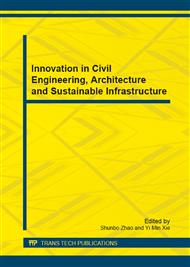p.447
p.451
p.455
p.460
p.466
p.470
p.473
p.478
p.482
Application of New Soil Consolidator in Road-Construction Engineering
Abstract:
This paper contrastively analyses the consolidation instances of silt with HEC and HAS soil consolidators, also emphatically discusses the influence regularities of the compressive strength of solidified soil with the following factors: the dose of consolidators and the curing time. Meanwhile, from the point of view of experiment, this paper studies the physical and mechanical properties of solidified soil. Case study shows that HEC and HAS soil consolidators behave as well as cement and lime in road-construction engineering, and even that filling subgrade independently. Also, this paper proposes the appropriate value 6% of HEC and HAS soil consolidators for solidifying silt layer, which can be used as reference for the similar geological conditions.
Info:
Periodical:
Pages:
466-469
Citation:
Online since:
November 2012
Authors:
Keywords:
Price:
Сopyright:
© 2012 Trans Tech Publications Ltd. All Rights Reserved
Share:
Citation:


